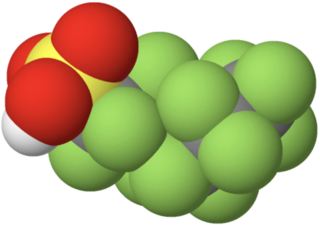Related Research Articles

Polytetrafluoroethylene (PTFE) is a synthetic fluoropolymer of tetrafluoroethylene, and has numerous applications because it is chemically inert. The commonly known brand name of PTFE-based composition is Teflon by Chemours, a spin-off from DuPont, which originally discovered the compound in 1938.

The Cape Fear River is a 191.08-mile-long blackwater river in east-central North Carolina. It flows into the Atlantic Ocean near Cape Fear, from which it takes its name. The river is formed at the confluence of the Haw River and the Deep River in the town of Moncure, North Carolina. Its river basin is the largest in the state: 9,149 sq mi.

Perfluorooctanoic acid is a perfluorinated carboxylic acid produced and used worldwide as an industrial surfactant in chemical processes and as a material feedstock. PFOA is considered a surfactant, or fluorosurfactant, due to its chemical structure, which consists of a perfluorinated, n-heptyl "tail group" and a carboxylate "head group". The head group can be described as hydrophilic while the fluorocarbon tail is both hydrophobic and lipophobic.

Perfluorooctanesulfonic acid (PFOS) is a chemical compound having an eight-carbon fluorocarbon chain and a sulfonic acid functional group and thus a perfluorosulfonic acid. It is an anthropogenic (man-made) fluorosurfactant, now regarded as a global pollutant. PFOS was the key ingredient in Scotchgard, a fabric protector made by 3M, and related stain repellents. The acronym "PFOS" refers to the parent sulfonic acid and to various salts of perfluorooctanesulfonate. These are all colorless or white, water-soluble solids. Although of low acute toxicity, PFOS has attracted much attention for its pervasiveness and environmental impact. It was added to Annex B of the Stockholm Convention on Persistent Organic Pollutants in May 2009.

A non-stick surface is engineered to reduce the ability of other materials to stick to it. Non-stick cookware is a common application, where the non-stick coating allows food to brown without sticking to the pan. Non-stick is often used to refer to surfaces coated with polytetrafluoroethylene (PTFE), a well-known brand of which is Teflon. In the twenty-first century, other coatings have been marketed as non-stick, such as anodized aluminium, silica, enameled cast iron, and seasoned cookware.
Perfluorononanoic acid, or PFNA, is a synthetic perfluorinated carboxylic acid and fluorosurfactant that is also an environmental contaminant found in people and wildlife along with PFOS and PFOA.
Per- and polyfluoroalkyl substances are a group of synthetic organofluorine chemical compounds that have multiple fluorine atoms attached to an alkyl chain. The PubChem database lists more than 6 million unique compounds in this group. PFASs started being used in the mid-20th century to make fluoropolymer coatings and products that resist heat, oil, stains, grease, and water. They are used in a variety of products including waterproof clothing, furniture, adhesives, food packaging, heat-resistant non-stick cooking surfaces, and the insulation of electrical wire. They have played a key economic role for companies such as DuPont, 3M, and W. L. Gore & Associates that use them to produce widely known materials such as Teflon or Gore-Tex.

Perfluorobutanesulfonic acid (PFBS) is a PFAS chemical compound having a four-carbon fluorocarbon chain and a sulfonic acid functional group. It is stable and unreactive because of the strength of carbon–fluorine bonds. It can occur in the form of a colorless liquid or a corrosive solid. Its conjugate base is perfluorobutanesulfonate which functions as the hydrophobe in fluorosurfactants.

A perfluorinated compound (PFC) or perfluoro compound is an organofluorine compound lacking C-H bonds. Many perfluorinated compounds have properties that are quite different from their C-H containing analogues. Common functional groups in PFCs are OH, CO2H, chlorine, O, and SO3H. Electrofluorination is the predominant method for PFC production. Due to their chemical stability, some of these perfluorinated compounds bioaccumulate.

Perfluorobutanoic acid (PFBA) is a perfluoroalkyl carboxylic acid with the formula C3F7CO2H. As the perfluorinated derivative of butyric acid, this colourless liquid is prepared by electrofluorination of the corresponding butyryl fluoride.

The Devil We Know is a 2018 investigative documentary film by director Stephanie Soechtig regarding allegations of health hazards from perfluorooctanoic acid, a key ingredient used in manufacturing Teflon, and DuPont's potential responsibility. PFAS are commonly found in every household, and in products as diverse as non-stick cookware, stain resistant furniture and carpets, wrinkle free and water repellant clothing, cosmetics, lubricants, paint, pizza boxes, popcorn bags, and many other everyday products.
The Chemours Company is an American chemical company that was founded in July 2015 as a spin-off from DuPont. It has its corporate headquarters in Wilmington, Delaware, United States. Chemours is the manufacturer of Teflon, the brand name of polytetrafluoroethylene (PTFE), known for its anti-stick properties. It also produces titanium dioxide and refrigerant gases.

Water contamination in Lawrence and Morgan Counties, Alabama, revolves around the presence of perfluorooctanoic acid (PFOA) and perfluorooctanesulfonic acid (PFOS) in the water supply. After the US Environmental Protection Agency (EPA) released new health advisories in March 2016, there was concern over health risks of the levels of PFOA and PFOS present. The responses of different government officials, agencies, and companies raise questions as to whether or not there was any environmental injustice involved.

FRD-903 is a chemical compound that is among the class of per- and polyfluoroalkyl substances (PFASs). More specifically, this synthetic petrochemical is also described as a perfluoroalkyl ether carboxylic acid (PFECA) and a Fluorointermediate. It is not biodegradable and is not hydrolyzed by water.

Perfluorobutane sulfonamide, also known as FBSA or H-FBSA, is a perfluorinated surfactant. FBSA and its N-alkylated derivatives have been patented by 3M for use in acid etch solutions with low surface tension. According to the inventors, FBSA and its derivatives are expected to have a smaller tendency to accumulate in living organisms than their perfluorooctanyl analogs such as PFOS. Nevertheless, a 2015 study found FBSA in 32 out of 33 samples of Canadian fish.
This timeline of events related to per- and polyfluoroalkyl substances (PFASs) includes events related to the discovery, development, manufacture, marketing, uses, concerns, litigation, regulation, and legislation, involving the human-made PFASs. The timeline focuses on some perfluorinated compounds, particularly perfluorooctanoic acid (PFOA) and perfluorooctanesulfonic acid (PFOS) and on the companies that manufactured and marketed them, mainly DuPont and 3M. An example of PFAS is the fluorinated polymer polytetrafluoroethylene (PTFE), which has been produced and marketed by DuPont under its trademark Teflon. GenX chemicals and perfluorobutanesulfonic acid (PFBS) are organofluorine chemicals used as a replacement for PFOA and PFOS.

Robert Bilott is an American environmental attorney from Cincinnati, Ohio. Bilott is known for the lawsuits against DuPont on behalf of plaintiffs injured by waste dumped in rural communities in West Virginia. Bilott has spent more than twenty years litigating hazardous dumping of the chemicals perfluorooctanoic acid (PFOA) and perfluorooctanesulfonic acid (PFOS).
Despite the best efforts of the government, health, and environmental agencies, improper use of hazardous chemicals is pervasive in commercial products, and can yield devastating effects, from people developing brittle bones and severe congenital defects, to strips of wildlife laying dead by poisoned rivers.

Perfluorohexanesulfonic acid (PFHxS) is a synthetic chemical compound. It is one of many compounds collectively known as per- and polyfluoroalkyl substances (PFASs). It is an anionic fluorosurfactant and a persistent organic pollutant with bioaccumulative properties. Although the use of products containing PFHxS and other PFASs have been banned or are being phased out in many jurisdictions, it remains ubiquitous in many environments and within the general population, and is one of the most commonly detected PFASs.

Fluoroether E-1 (known chemically as heptafluoropropyl 1,2,2,2-tetrafluoroethyl ether, is a chemical compound that is among the class of per- and polyfluoroalkyl substances. This synthetic fluorochemical is used in the GenX process, and may arise from the degradation of GenX chemicals including FRD-903.
References
- ↑ "C3 Dimer Acid and PFAS". Chemours. Retrieved 23 January 2020.
- 1 2 3 Beekman, M.; et al. (2016-12-12). "Evaluation of substances used in the GenX technology by Chemours, Dordrecht" (PDF). National Institute for Public Health and the Environment (RIVM, The Netherlands). Retrieved 2017-07-23.
- 1 2 3 Hogue, Cheryl (2018-02-12). "What's GenX still doing in the water downstream of a Chemours plant?". American Chemical Society (ACS). Retrieved 2019-08-21.
- ↑ "Basic Information on PFAS". PFOA, PFOS and Other PFASs. Washington, D.C.: U.S. Environmental Protection Agency (EPA). 2018-02-18.
- ↑ "GenX Frequently Asked Questions" (PDF). GenX Investigation. Raleigh, NC: North Carolina Department of Environmental Quality (NCDEQ). 2018-02-15.
- ↑ "What is the difference between PFOA, PFOS and GenX and other replacement PFAS?". PFOA, PFOS and Other PFASs. EPA. 2018-02-18.
- ↑ "What is GenX? | Get the Facts".
- ↑ Lau C.; Anitole K.; Hodes C.; Lai D.; Pfahles-Hutchens A.; Seed J. (October 2007). "Perfluoroalkyl acids: a review of monitoring and toxicological findings". Toxicol. Sci. 99 (2): 366–94. doi: 10.1093/toxsci/kfm128 . PMID 17519394.
- ↑ Caverly Rae, JM; Craig, Lisa; Stone, Theodore W.; Frame, Steven R.; Buxton, L. William; Kennedy, Gerald L. (2015). "Evaluation of chronic toxicity and carcinogenicity of ammonium 2,3,3,3-tetrafluoro-2-(heptafluoropropoxy)-propanoate in Sprague–Dawley rats". Toxicology Reports. 2: 939–949. doi:10.1016/j.toxrep.2015.06.001. PMC 5598527 . PMID 28962433.
- ↑ Lerner, Sharon (2016-03-03). "New Teflon Toxin Causes Cancer in Lab Animals". The Intercept. Retrieved 2018-12-14.
- ↑ "DuPont GenX Processing Aid for Making Fluoropolymer Resins" (PDF). 2016-02-09. Archived from the original (PDF) on 2018-02-08. Retrieved 2019-08-21.
- ↑ "N.C. drinking water tainted with chemical byproduct for decades?". CBS News. 2017-06-26.
- ↑ Strynar, Mark J.; Dagnino, Sonia; Lindstrom, Andrew; Andersen, Eric; Mcmillan, Larry; Thurman, Michael; Ferrer, Imma; Ball, Carol (2012). Identification of novel polyfluorinated compounds in natural waters using accurate mass TOFMS. SETAC. Long Beach, CA – via ResearchGate.
- ↑ Strynar, Mark J.; McMahen, Rebecca; Liang, Shuang; Dagnino, Sonia; Lindstrom, Andrew; Andersen, Erik; McMillan, Larry; Thurman, Michael; Ferrer, Imma; Ball, Carol (November 9–13, 2014). Determination of perfluoroalkyl ether carboxylic acids (PFECAs) and sulfonic acids (PFESAs) in North Carolina surface water using high resolution mass spectrometry. SETAC. Vancouver, BC – via Researchgate.
- ↑ McCord, James; Strynar, Mark (2019-05-07). "Identification of Per- and Polyfluoroalkyl Substances in the Cape Fear River by High Resolution Mass Spectrometry and Nontargeted Screening". Environmental Science & Technology. 53 (9): 4717–4727. Bibcode:2019EnST...53.4717M. doi:10.1021/acs.est.8b06017. ISSN 0013-936X. PMC 7478245 . PMID 30993978.
- ↑ Sun, Mei; Arevalo, Elisa; Strynar, Mark; Lindstrom, Andrew; Richardson, Michael; Kearns, Ben; Pickett, Adam; Smith, Chris; Knappe, Detlef R. U. (2016-12-13). "Legacy and Emerging Perfluoroalkyl Substances Are Important Drinking Water Contaminants in the Cape Fear River Watershed of North Carolina". Environmental Science & Technology Letters. 3 (12): 415–419. Bibcode:2016EnSTL...3..415S. doi:10.1021/acs.estlett.6b00398.
- ↑ "GenX Timeline". NCDEQ. Archived from the original on 2018-12-24. Retrieved 2018-04-22.
- ↑ Clabby, Catherine (2017-11-02). "Newest GenX Lawsuit Attacks DuPont Science". Chapel Hill, NC: North Carolina Health News.
- ↑ https://capefearriverwatch.org/genx/
- ↑ Alder, Cole (2018-05-16). "Cape Fear River Watch to file suit against Chemours". Per- and Polyfluoroalkyl Substances; News. Boston, MA: Northeastern University, Social Science Environmental Health Research Institute.
- ↑ https://capefearriverwatch.org/genx/
- ↑ https://www.chemours.com/en/about-chemours/global-reach/fayetteville-works/compliance-testing
- ↑ https://capefearriverwatch.org/genx/
- ↑ https://edocs.deq.nc.gov/WaterResources/DocView.aspx?id=611983&dbid=0&repo=WaterResources&searchid=627d7915-27f4-4e8b-beb3-ec53cd75941b
- ↑ https://genxstudy.ncsu.edu/
- ↑ Matheny, Keith (3 August 2020). "Michigan's drinking water standards for these chemicals now among toughest in nation". Detroit Free Press. Archived from the original on 31 January 2022. Retrieved 31 March 2022.
- ↑ "New state drinking water standards pave way for expansion of Michigan's PFAS clean-up efforts". Michigan.gov. 3 August 2020. Archived from the original on 3 January 2022. Retrieved 5 April 2022.
- ↑ "Source of 'forever chemical' in the Roanoke River traced to Elliston plant". 10 November 2022.
- ↑ Phelps, Drake W.; Palekar, Anika I.; Conley, Haleigh E.; Ferrero, Giuliano; Driggers, Jacob H.; Linder, Keith E.; Kullman, Seth W.; Reif, David M.; Sheats, M. Katie; DeWitt, Jamie C.; Yoder, Jeffrey A. (2023-12-31). "Legacy and emerging per- and polyfluoroalkyl substances suppress the neutrophil respiratory burst". Journal of Immunotoxicology. 20 (1): 2176953. doi: 10.1080/1547691X.2023.2176953 . ISSN 1547-691X. PMC 10361455. PMID 36788734. S2CID 256870330.
- ↑ "EPA Announces New Drinking Water Health Advisories for PFAS Chemicals, $1 Billion in Bipartisan Infrastructure Law Funding to Strengthen Health Protections". EPA. 2022-06-15. News release.
- ↑ "Drinking Water Health Advisories". EPA. 2022-06-15.
- ↑ "Meaningful and Achievable Steps You Can Take to Reduce Your Risk". PFOA, PFOS and Other PFAS. EPA. 2022-08-18.